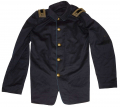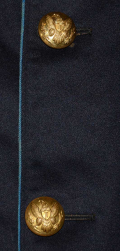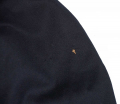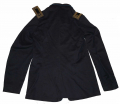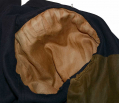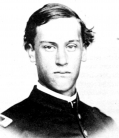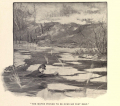site search
online catalog
OFFICER’S SACK COAT OF BREVET MAJOR SAMUEL RODMOND SMITH, 4TH DELAWARE, MEDAL OF HONOR RECIPIENT
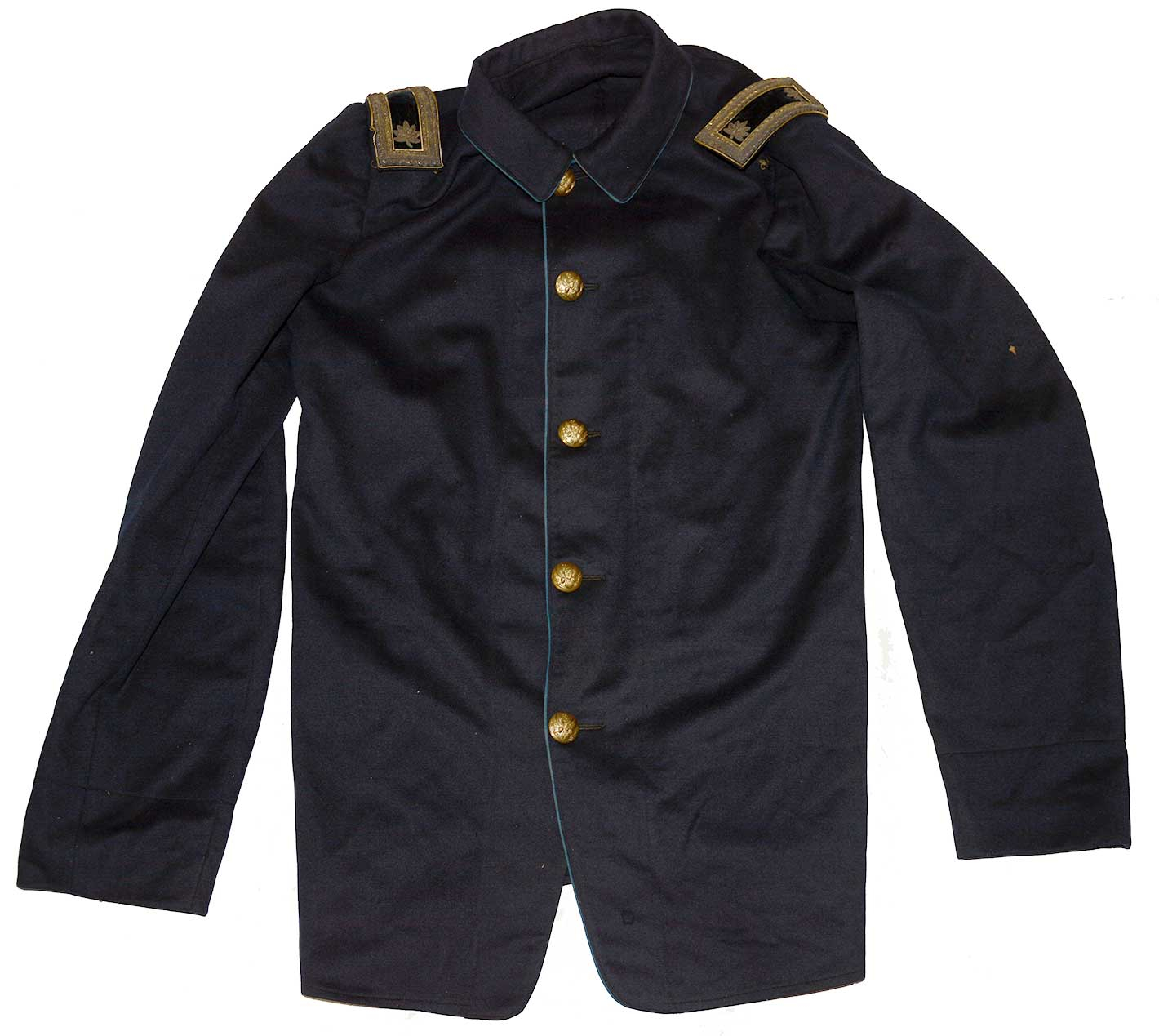
$6,500.00 SOLD
Quantity Available: None
Item Code: 1179-654
This officer’s sack coat comes from the collections of the Texas Civil War Museum and is identified to Maj. Samuel Rodmond Smith, 4th Delaware, who received the Medal of Honor for actions in the opening movements of the Battle of Hatchers Run in February 1865 during the siege of Petersburg.
The coat is light-weight officer’s sack coat typical of commercially purchased officer’s coats worn for undress or field service, modeled on the enlisted fatigue blouse, but of higher quality. It has a roll-over collar like the enlisted issue version and no buttons on the cuffs, but rather than four buttons is fastened by five, which is commonly seen in period photos of officers. The collar has a single hook-and-eye closure and light blue piping around the front and lower edge welted into the seam. The buttons are large Eagle-I infantry officer buttons, four with matching Extra Quality back marks and one with a Waterbury Button Co. mark. The body is unlined, but fitted with a single large pocket of polished cotton inside the left breast. The sleeves are lined with a plain white muslin stained tan from wear, but in very good condition as is the rest of the coat, with tight seams, strong color, practically no moth damage- we see just a couple of pencil-point moth nips.
The only ornamentation on the coat aside from the collar piping is a very nice set of triple bordered embroidered bullion officer’s shoulder straps fixed on the shoulders by hooks sewn under the corners of the straps to engage loops of thread sewn on the coat. Both straps have deep black, velvet centers, inner and outer narrow borders showing alternating dull and bright bullion, along a wider, plain middle border. The gilt jaceron wire borders have bright color as does the bright bullion on the inner and outer borders, especially on the wearer’s left strap. The other bullion has oxidized to a muted silver as has some of bullion making up the gold leaves of the rank insignia. The jaceron wire on the wearer’s right strap has pulled up in a couple of places, but could be tacked down again. That strap shows a bit more oxidation than the left. The hook on the lower inner corn of the left strap has pulled loose. We note a sewn tag on the underside of that strap reading “Rochester Historical Society.” We do not know which Rochester that refers to or the provenance of the coat before its acquisition by the Texas Civil War Museum. Smith does not seem to have had direct descendants, but he had a number of nieces and nephews, one of whom, born in 1883, was his namesake.
Smith was born in Wilmington, Delaware, in 1841 and in 1860 was living there with his parents and five siblings, working as a clerk. He received enlisted and was commissioned a Captain in the 4th Delaware on July 13, 1863. The regiment had been organized in late Summer and early Fall 1862 and, remarkably, contained a lot of “galvanized yankees,” captured Confederates who took an oath of allegiance and agreed to serve in the Union army. They were initially posted to Baltimore and then served on the Peninsula in the first part of 1863, taking part in numerous expeditions, including Dix’s June and July campaign to draw forces from Lee’s offensive in the Gettysburg campaign. When Smith joined it they were part of the 22nd Corps in the Washington defenses, serving at Centreville, Fairfax Station and guarding rail lines, with a brief stint back in Delaware, according to one source guarding the Dupont gunpowder mills.
They were ordered to join the Army of the Potomac in May 1864 for Grant’s overland campaign as part of the 5th Corps and were credited with the following actions: Totopotomoy May 29–31. Cold Harbor June 1–12. Before Petersburg June 16–18. Mine Explosion, Petersburg, July 30, 1864 (reserves). Weldon Railroad, August 18–21. Poplar Springs Church September 29-October 1. Yellow House October 1–3. Boydton Plank Road, Hatcher's Run, October 27–28. Warren's Raid on Weldon Railroad December 7–12. Dabney's Mills, Hatcher's Run, February 5–7, 1865. Appomattox Campaign March 28-April 9. Lewis Farm, near Gravelly Run, March 29. White Oak Road March 30. Gravelly Run March 31. Five Forks April 1. Fall of Petersburg April 2. Pursuit of Lee April 3–9. Appomattox Court House April 9. Surrender of Lee and his army. The regiment had lost 85 officers and men in killed or mortally wounded alone during its service, with the largest part of its battle casualties suffered in 1864. By the time of the surrender there were only 63 officers and men in the ranks, then part of a consolidated battalion of Delaware troops, which was under Smith’s command.
Smith received the Medal of Honor for actions at the opening of the Battle of Hatcher’s Run, a three-day affair from Feb. 5-7, 1865, in the siege of Petersburg, when Grant had sent a cavalry division off to his left to capture or destroy Confederate supply wagons on the Boydton Plank Road. To protect the cavalry’s right, the 5th Corps was ordered to cross the Monk’s Neck Bridge over Rowanty Creek to take up a blocking position on the Vaughan Road. They arrived at the creek to find Confederates had destroyed the bridge and constructed entrenchments along the bluffs overlooking the creek. Other troops from the brigade were unable to force a crossing and the 4th Delaware was ordered to do it. Smith recounted:
"Our regiment, with Major D. H. Kent in command, was then detailed for the service, and immediately moved down the road toward the crossing. The ground was slightly rolling and open farmland, except near the bank of the stream, where a thin skirt of trees bordered the river, affording some cover. Major Kent, finding that the bridge was destroyed, filed the regiment to the right, under heavy fire, but somewhat protected by the trees. He then endeavored to lead the regiment across the river, but was shot while swimming his horse and was carried to the rear.
"There was considerable floating ice in the stream, and the regiment, seeing the depth of the water, did not cross, but continued to move slowly to the right, keeping up a brisk fire on the enemy. At a point some two or three hundred feet farther to the right I observed some bushes projecting from the water, and, thinking this an indication that the water was shallow enough to wade, called on my command to follow me, and sprang into the stream. The water proved to be over six feet deep within that distance from the shore, but I was a strong swimmer, and although encumbered by a haversack belt and cape overcoat, succeeded in reaching a small island in mid-stream, under a heavy plunging fire which splashed the water around me. In the meantime the regiment moved cautiously forward among the scattered trees to the right, and shortly after crossed the stream to the island upon the ice which had formed during the preceding two days and nights and the fallen logs frozen to the surface. From thence all hands slid and waded to the opposite shore and we carried the enemy's entrenchments with a rush, capturing some fifty or sixty rebels. The remainder of their forces had retired before we reached their works. After a short time spent in re-forming the regiment we pushed ahead in quick time until the evening and on the following day participated in the action at Hatcher's Run, Virginia."
The engagement itself was not large, but getting the infantry supports into position proved essential as Lee committed sizable Confederate forces over the next two days to counterattack what he thought might be large scale offensive. Fighting ended with about 2,600 casualties, and no substantial losses to Confederate supply trains, but with Grant’s siege line extended and Lee’s forces stretched even more thinly. Smith was brevetted Major March 13, 1865, and in 1895 received the Medal of Honor for his actions.
Smith mustered out June 3, 1865, and studied law, passing the bar in 1866. He worked for an insurance company and from 1873 served for thirty years as Clerk of the US District Court for Delaware. He reported traveled for a time after retiring, but settled in Florida, where he died in September 1912, having served as Mayor of Miami, but was interred back in Delaware. His wife survived him until 1937. [sr] [ph:L]
~~~~~~~~~~~~~~~~~~~~~~~~~~~~~~~~~~~
THIS ITEM, AS WITH ALL OTHER ITEMS AVAILABLE ON OUR WEB SITE,
MAY BE PURCHASED THROUGH OUR LAYAWAY PROGRAM.
CLICK HERE FOR OUR POLICIES AND TERMS.
THANK YOU!
Inquire About OFFICER’S SACK COAT OF BREVET MAJOR SAMUEL RODMOND SMITH, 4TH DELAWARE, MEDAL OF HONOR RECIPIENT
For inquiries, please email us at [email protected]
Most Popular
Historical Firearms Stolen From The National Civil War Museum In Harrisburg, Pa »
Theft From Gravesite Of Gen. John Reynolds »
Cavalry Carbine Sling Swivel »
Fine Condition Brass Infantry Bugle Insignia »
featured item
CDV OF 2ND LIEUTENANT CHARLES E. CROW, 4TH VA. (PURCELL) LIGHT ARTILLERY
This is a very nice CDV photograph of Charles E. Crow in Confederate uniform. It appears to be a second-generation image; photo of an existing photo. Regardless, the picture is clear with good contrast. Crow wears a Confederate 2nd lieutenant's,… (1138-988). Learn More »



